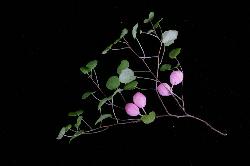- Taxon
- Gallery
Subdioecious prostrate subshrub, sometimes almost scrambling or pendulous. Stems very slender < 5 mm diam., to c. 70 cm long; branchlets very slender, glabrous. Petioles almost filiform, to 15–(30) mm long, sparsely hairy. Lamina 5–15–(20) × 5–14–(20) mm, suborbicular to broad-ovate, membranous, glabrous or glabrate, sinuate to subserrulate; base subcordate; apex obtuse to rounded. Fls solitary, erect; pedicels usually c. 5 mm long at anthesis, slender. Floral tube, 6–12 mm long, tubular-campanulate. Sepals 5–8 mm long, lanceolate or narrow-lanceolate, purplish at tips, sharply reflexed. Petals 0. Filaments 2–4 mm long, slender, purple. Style 8–16 mm long, much > staminodes in ♀ fls, almost = stamens in ☿ fls; stigma capitate to 4-lobed. Berry 15–25 mm long, ovoid-oblong to obovoid, crimson to magenta.
[From: Webb et al. (1988) Flora of New Zealand. Volume 4.]
Flowering: Oct.–Feb.




